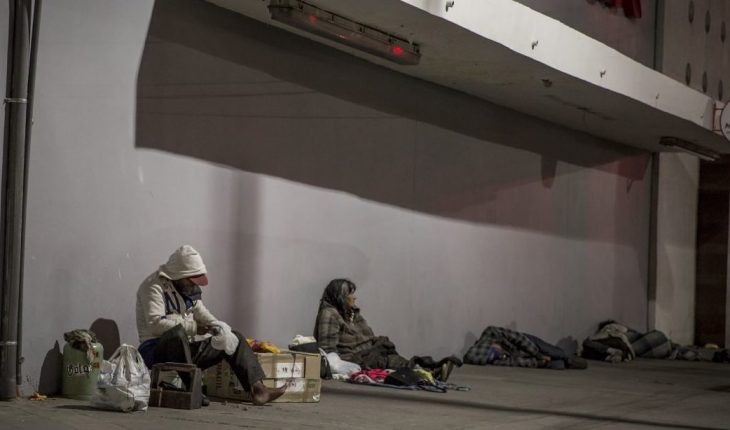Philip takes his hand to his nose, inhales. With a few more times it will be enough to stop feeling hungry and cold. He’ll fall asleep. It will be invisible to the hundreds of people who pass daily by your side, near where you live, the entrance of the Garibaldi metro, in Mexico City, and who prefer not to look at it.
He inhaled solvents from the age of 12, when he left home fed up with the beatings and mistreatment he suffered. He’s 26 now. All that time he has lived on the street in several states: Michoacán, State of Mexico and Guanajuato. The worst time for him is the rainy season, because finding a place to be garnished is complicated.
You may be interested: Bad treatment and torture, treatment at rehabilitation centers in Mexico
Felipe consumes solvents, the easiest drugs to obtain, the cheapest, and the ones that affect the most vulnerable populations both in the city and in rural areas. Solvents are not illegal, they are for sale and available to anyone.
“They are so available and available to the most vulnerable, say children, young people or people who are in depression or in a situation of sadness,” says Enrique Hernández director of the Civil Association El Caracol, which serves street populations.
Although it is easy to fall into this addiction, few places have health care protocols for consumers, as these drugs do not have the reflectors of others such as cocaine, marijuana, or now fentanyl and glass.
Marijuana is the most commonly used substance to start in illegal drugs in 73.9% of cases, followed by inhalables (8.1%) and cocaine (7.9%), according to data from the Epidemiological Drug Use Information System (SIECD) 2018.
Toluene is the main inhalable consumed in Mexico and used to make “monas”, consisting of a piece of cloth, paper, gauze or other fiber moistened with this substance to inhale it.
This chemical serves as an additive in gasoline and for the manufacture of other products such as plastics, explosives, inks and solvents. As a substance for industrial use and not a drug, it is legal and distributed throughout the country and is for sale in tlapal shops and other expendios; it’s cheap and relatively easy to get.
Just a few pesos to buy it.
“With 5 pesos they gave me a medium bottle, 600 (milliliters), full. I gave up about a day or even less, it depends. Because I liked it, I had it and I wanted more. Although already, my hand was drained but I felt that it was already dry and I was getting more paper and paper wet,” says Gabriel who consumed inhalables and drugs since I was 6. He’s 36 now.
Pedro, who has always lived in Malinalco, State of Mexico, could get it at any hardware store, without being asked for identification or asked what he wanted it for.
The monkey arrives with the “friends”
When they were in high school Victor and Ulysses, both inhabitants of Malinalco, first tested the solvents.
“That’s when I started trying them, when I walked in, first of high school, that’s when I started with the monkey. Then with the glass, and then with the marijuana,” says Victor, who is now 19 years old and dedicated to making carved figures of wood.
Between 2002 and 2017, inhalable use among the population aged 12 to 25 increased by 1.7% in the country, according to the 2017 National Drug, Alcohol and Tobacco Use Survey.
Ulysses, who is now 22 years old and stopped using drugs, points out that his peers got the solvent, “I didn’t need to buy it, because several were already bringing and so, nothing else was that: ‘wet my paper'”. At first they were two or three times a day, then consumed one or two cans of PVC cleaner, which contains toluene.
Toluene is a colorless liquid, with a sweet and moderately water-soluble smell. Inhaling it causes an “initial excitement that goes into disinhibition, with a feeling of lightness, euphoria and agitation,” the study notes Let’s talk about Theluene carried out by the organization Imagination Laboratory and Social Action, A.C. (Imaginalco).
Victor stole to get money and buy these substances. “Sometimes, as I was very cute, sometimes once again I did start to assault.”
Of the teenagers who committed a crime under the effects of any drug, alcohol (47.7%) was identified was the most commonly used substance under this situation, followed by inhalables (24.6%) marijuana (16.9%), according to the Epidemiological Surveillance System of Addiction, 2018.
Imaginalco detected that there is a high consumption of inhalables by vulnerable children and young people at the municipal head of Malinalco, State Mexico. In Mexico City, inhalables are the drug most commonly used in people in street situations, according to the 2017 Census of Street Populations.
When Gabriel and Felipe began living on the streets of Mexico City, as children, it was other people in this situation who gave them solvents.
“They were boys I was hanging out with. I asked them to eat and it was very cold (…) And they said, no, because give him a monkey. But since I was a little boy, I thought a monkey who walks in the zoo, right? And from there I started to try, I started to know the drug and they taught me more drugs than I knew,” says Gabriel who, losing his parents at age 6, started living on the street.
According to Imaginalco’s study, they are also consumed by young people and children from vulnerable neighborhoods prisons, gamers, or other population working on the streets. The use of toluene, the study notes, is more common in groups than individually, leading to a “collective hallucination” in which the use “of these drugs can help strengthen collective bonds and strengthen their interaction”.
“If you’ve seen a band that’s with a caguama, because we were no longer a caguama, it was a can,” says Ulysses. In Malinalco, not far from the tourist area of the village, young people gather at certain points to consume solvents.
The effects of consumption
“When I started consuming it I felt like I was moving things. I would carry things with my hands, with my sight I would change places and all that, I felt like powerful, I felt like I was floating, when I walked like I was flying, so I felt. I was starving, the cold, that’s why I was grabbing the inhalants,” says Gabriel, who lives in Mexico City.
But when the effect of the toluene passed “I felt very cold and a lot of headache and I was shaking.”
Headache, lethargy and lack of muscle coordination are some of the effects that inhalable consumption causes in people. “The sensation is similar to the hangover generated by other substances, popularly known as alcohol-consumption raw,” Imaginalco’s study notes.
There are also neurological effects such as encephalopathy, peripheral neuropathy, disorders in eye movements, loss of sensation, vision, dementia, etc. Prolonged consumption of toluene can cause brain abnormalities at the structural and functional level in the human brain.
“It did affect me that then I forget things, suddenly I’m doing something and saying, “What did I come to bring? And I turn around and say, what was I been looking for, right? Things like that,” Pedro says.
Why it’s so easy to get it
Toluene is in a legal limbo, as there is no rule that regulates or prohibits its use, as it is listed as a substance for industrial use.
Anyone may import or export quantities less than 1,500 kilograms of toluene without having to account for any authority or require a permit, as it is listed as an essential chemical in the Chemical Precursors Act.
The General Health Law also does not regulate it, because although it is a psychotropic it is not included in the five groups in which these substances are classified, nor are they on the list of narcotics in Article 234.
The same law, article 254, details that the government should prevent minors and others from consuming these substances, through the monitoring of the establishments that sell it, and provide medical care to those who already consume it. In addition to promoting ongoing information and public guidance campaigns, to prevent damage to health caused by consumption.
In addition, PVC cleaner packaging (containing toluene) does not have a clear legend about the dangers involved in consumption and handling.
“The official Mexican standards issued for psychotropic products are designed for drugs and similar products and do not extend to other products such as PVC cleaner,” says Imaginalco’s study.
In Mexico, the Federal Commission for the Protection of Health Risks (COFEPRIS) is responsible for regulating, monitoring and monitoring the management of substances toxic or hazardous to health, essential chemicals, narcotics and psychotropics as well as the establishments dedicated to their process or storage.
In rural environments it is friends who share the solvents, “among the population that inhabits the streets of the city is usually a dealer official in each group of street population, which in turn can count on several small distributors, who are usually users of the substance.
This creates a hidden and captive asset market that generates lucrative microeconomics,”wing the studio.
“Among the same colleagues there are places, well, there are places, it is not said, but there are places where you can get fast,” says Gabriel, who lived and now works in the Garibaldi metro area in Mexico City.
People, not ghosts
People who consume inhalables are much less visible than consumers of other substances, explains Dr. Silvia Cruz, “and not in the sense that we don’t bump into them on the street, but they don’t have an impact as celebrities can have.”
Vulnerable sectors, says the pharmacologist of the Center for Research and Advanced Studies of the National Polytechnic Institute (Cinvestav), are people who will not organize the property in sectors to ask for attention, because they do not have as much social representation, “somehow even though we see them is an invisible population or they want it to be invisible”.
In addition to gang fights, assaults, consumers of inhalables also face discrimination and abuse by authorities who have an obligation to attend to them.
Cruz Martín del Campo explains that when they suffer a crisis from intoxication, paramedics do not want to put them in the ambulance because they claim that because of their lack of hygiene (in the case of a street population) they must then disinfect it before they can get on someone else and that takes away a day of service.
Imaginalco’s study notes that women who are from street toluene are even more vulnerable to sexual abuse, to become pregnant as they are often conditioned on access to health services in exchange for handing over their children for adoption or taking them off to take them to aid institutions.
“If a woman is intoxicated there may be obstetric violence, she does not bring papers, she has a low hygiene situation, she did not have prenatal care and that if they are intoxicated or anesthetized they give them.
In death too, consumers are invisible.
Silvia Cruz points out that there is a sub-registration in the case of street population deaths related to inhalables.
“It is said to die of cold, but in his hand he brings a monkey. She died of cold because the hypothermia didn’t notice her because she was intoxicated. Maybe he died of cardiac arrest because solvents and gases affect the heart a lot but he was found the next day dead of cold,” he explains.
“As they live in street conditions because he died of cold, or he was run over. No one recorded the birth, recorded death less or there are no papers, so the under-registration is immense,” she adds.
Recognize the problem
Enrique Hernández, director of Caracol points out that to find a solution to the problem it must be recognized that toluene is a legal substance, which causes irreversible damage in any population that is consuming.
“The first thing is to recognize that solvents are in every house in the country, everyone can have a varnish, a down, one of these air for computers, can have water, thiner or toluene in the house. It is so available, let us recognize that it does not have to be available to the most vulnerable people, say children, young people or people who are in depression or in a situation of sadness,” Enrique adds.
Silvia Cruz, PhD in Pharmacology at Cinvestav, points out that if you have products containing solvents in the home you must be under lock and key; in the case of establishments there must also be greater control over the sale.
Would putting a warning on labels on PVC cleaner cans and other containers, as was done with cigarette packs, help decrease consumption? Cruz Martín del Campo is questioned.
“Labeling isn’t everything, who wants to use it will use it, maybe it serves more for the non-user, for the dad, to say these things can’t be like that or alert a little, if in your house suddenly a teenage son who never cleans anything gives him to buy computer cleaners, he’s probably using it. (Change the labeling) has a little piece of contribution but it’s not that much,” the specialist replies.
What we do in Animal Político requires professional journalists, teamwork, dialogue with readers and something very important: independence. You can help us keep going. Be part of the team.
Subscribe to Animal Politics, receive benefits and support free journalism #YoSoyAnimal.
translated from Spanish: Toluene, the drug that takes away hunger, cold and kills slowly
August 21, 2020 |





